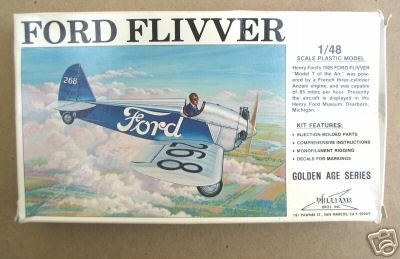
| KIT: | Williams Bros 1/48 Ford Flivver |
| KIT #: | 48-661 |
| PRICE: | $ |
| DECALS: | One option |
| REVIEWER: | John Sachs |
| NOTES: | Currently out of production |

| HISTORY |
In 1926, life in the United States saw the invention of the pop-up toaster, the first talking motion picture starring Al Jolson as the Jazz Singer and the first liquid fuel-propelled rocket launched by Robert Goddard. During that time, Ford was dabbling around in personal aircraft. Already successfully producing the Ford Tri-motor, they decided that it was time to create a personal aircraft for public. Otto Koppen, a young Ford employee who recently graduated from the Massachusetts Institute of Technology (MIT), was given the task to develop the small aircraft called the Model 2A also known as the ďFlivverĒ.
During the development, the aircraft would see two power plants: a French a 36 horsepower three-cylinder Anzani and a 40 horsepower two-cylinder Ford engine. The airframe would see multiple configuration types such as full span ailerons, which also functioned as landing flaps. These ailerons worked in conjunction with the elevators and operated accordingly. It was then decided that more conventional ailerons were to be installed and the full span ones where deleted. Other airframe changes would include modifications to the landing gear, the addition of a headrest and a change in the engine cowling to correspond with the two different engines types.
During that time an updated version of model 2A was developed and test pilot Harry Brooks took controls of plane and set it through its paces. It was said that only two pilots ever flew the model 2A. Harry Brooks being one of them and Charles Lindbergh being the other. Both were very trusted friends of Henry Ford. In 1928, Brooks took the updated version of the model 2A, which was a two-cylinder Ford engine on a flight from Michigan to Florida. For reasons unknown, the plane went down into the ocean near Melbourne Florida killing pilot Brooks. Ford became disillusioned with project and ordered it cancelled immediately. Only the prototype model 2A exists as well as a 2-cylinder Ford engine that was used in the aircraft that Brooks flew. Those can be seen in the Henry Ford Museum in Dearborn Michigan.
| THE KIT |
 The Williams Bros 1/48 Ford Flivver
comes in a rather flat cardboard box. The contents of the kit are a single
sprue, which includes the entire kit itself. This kits a rather small kits. In
fact itís so small that it could easily be compared to size wise to 1/72 scale
WWII fighter. The kit also comes with a small piece of acetate for the
windshield and some fishing line to for the rigging that will be required. Also
included are decals for ship 268 as well as a single instruction sheet that is
double sided. The instruction sheet starts out with a brief history, and a set
of references as well as some black and white shots of the model 2A with the
3-cylinder French Anzani Engine. From there it jumps right into construction.
On the opposite side are the decal placement and the exploded view of the kitís
assembly sequence. Looking at the instructions, the modeler has the option to
build a ship with expanded aileron horns or shorten. Overall, the assembly
sequence is pretty straightforward
The Williams Bros 1/48 Ford Flivver
comes in a rather flat cardboard box. The contents of the kit are a single
sprue, which includes the entire kit itself. This kits a rather small kits. In
fact itís so small that it could easily be compared to size wise to 1/72 scale
WWII fighter. The kit also comes with a small piece of acetate for the
windshield and some fishing line to for the rigging that will be required. Also
included are decals for ship 268 as well as a single instruction sheet that is
double sided. The instruction sheet starts out with a brief history, and a set
of references as well as some black and white shots of the model 2A with the
3-cylinder French Anzani Engine. From there it jumps right into construction.
On the opposite side are the decal placement and the exploded view of the kitís
assembly sequence. Looking at the instructions, the modeler has the option to
build a ship with expanded aileron horns or shorten. Overall, the assembly
sequence is pretty straightforward
| CONCLUSIONS |
This looks like one a rather neat model to build. The kit has been around for quite awhile, but itís a neat subject that none of the mainstream folks would have probably touched upon. There is some scratch building thatís going to need to be completed but itís nothing that the average modeler canít handle.
| REFERENCES |
http://www.popsci.com/popsci/aviationspace/8ca6d4d03cb84010vgnvcm1000004eecbccdrcrd.html
http://www.hfmgv.org/museum/heroes/entrepreneurs/flivver.asp
March 2007
If you would like your product reviewed fairly and quickly by a site that has over 350,000 visitors a month, please contact me or see other details in the Note to Contributors.